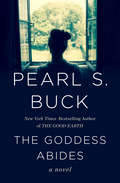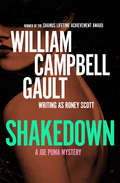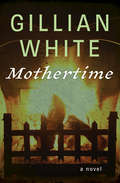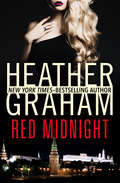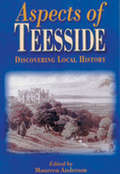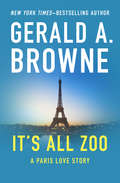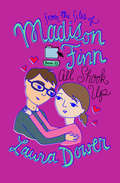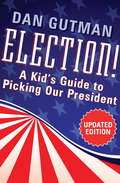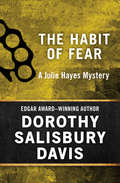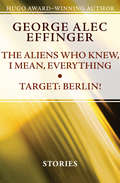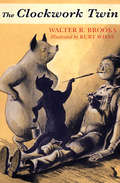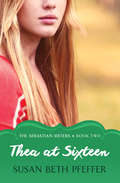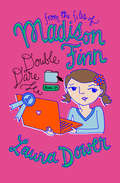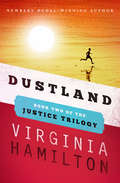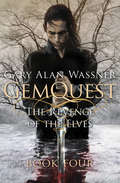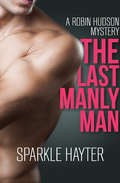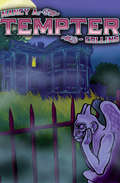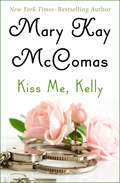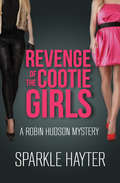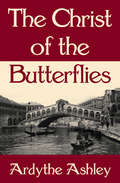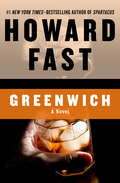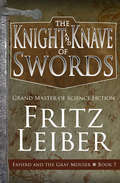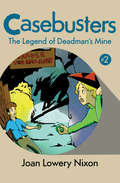- Table View
- List View
The Goddess Abides: A Novel
by Pearl S. BuckA widow&’s New England peace is interrupted by her feelings for two brilliant men, one much younger and the other quite older—and the dilemma of choosing between themAt forty-three, Edith has lost a husband, and has children who have children of their own. Living in a large Vermont house, her days are spent idly reading and playing music. But all of this is to change when two candidates for her affection arrive on the scene. The first is thirty years her senior, a philosopher named Edwin with whom she enjoys an enriching intellectual friendship. The second, Jared, is twenty years her junior: a handsome scientist, he attracts Edith in mind and body. But even if Jared shares her passion, does he have enough life experience to know whether such a union is in his best interests? In this exquisite and probing examination of desire, contrasting passions come to a head. This ebook features an illustrated biography of Pearl S. Buck including rare images from the author&’s estate.
The Evil Shepherd
by E. Phillips OppenheimA former defense attorney turned righteous crusader is the hero of this blockbuster novel from an early master of the thriller genre A businessman is found stabbed through the heart, the obvious suspect his partner: Oliver Hilditch, a cold-eyed fellow with a paper-thin alibi. Hilditch seems destined for the gallows, but he is saved by brilliant defense attorney Francis Ledsam, who uses every legal trick he knows to free his client. It is a defense to be proud of, but Ledsam&’s joy vanishes when Hilditch&’s wife informs him that her husband is guilty of crimes far more monstrous than murder. His faith in his career shaken, Ledsam vows never again to defend a guilty man. But when his newfound principles run up against the harsh reality of real-world justice, he finds himself trapped between his love for a beautiful woman and a powerful desire to do the right thing—no matter the cost. This ebook has been professionally proofread to ensure accuracy and readability on all devices.
Shakedown: A Joe Puma Mystery
by William Campbell GaultA corrupt P.I. will do anything to make a buck and save his own skinJoe Puma didn&’t kill Albert Target, but he is happy the pimp is dead. A small-time creep whose niche was recruiting wannabe actresses, Target perjured himself for Puma&’s sake, and the detective was afraid he might decide to talk. The cops know that Puma&’s crooked, but they can&’t prove a thing. He&’s a slick operator with an itchy trigger finger and a flimsy moral code—two things he&’ll need if his next case is to end as happily as his last. Fallen starlet Jean Roland comes to Puma with a plan to blackmail her lesbian lover&’s father—a dangerous scheme that would put Puma off if Roland weren&’t the most stunning woman in Los Angeles. Joe Puma likes money and he likes being alive, but he likes women even more. He&’d die for a girl like Jean Roland—but he&’d prefer it if someone else died first.
Mothertime: A Novel
by Gillian WhiteIn this dark comedy, five siblings who are fed up with their mother&’s negligent parenting conspire to teach her a lesson Caroline Townsend is a nightmare for her children. The former actress and current alcoholic hits her nadir on Christmas Eve. Her five young children hope for a Christmas celebration. Instead, they get a fight with their mother, who&’s absolutely plastered and fresh off yet another failed relationship. After lashing out at her children, Caroline passes out under the bent and mangled Christmas tree. For the Townsend children, this proves to be a rare opportunity—a chance to set things right with their mother. Together, they concoct an elaborate ruse designed to teach her a lesson, once and for all. Mothertime finds Gillian White at her uproarious best as she nimbly skewers motherhood and modern marriage.
Red Midnight
by Heather GrahamOn a trip to the Soviet Union, an American model finds herself stuck in a deadly game of espionageErin McCabe is taking the trip of a lifetime to Soviet Russia. Before she even crosses the border, she has a series of run-ins with the ruggedly handsome American diplomat Jarod Steele. But how coincidental are these encounters? In a flash, Erin finds herself at the center of a wild spy plot, where truth is indistinguishable from falsehood, and the difference between good guys and bad guys is impossible to tell. This ebook features an illustrated biography of Heather Graham including rare photos from the author&’s personal collection.
Aspects of Teeside: Discovering Local History
by Maureen AndersonThe Aspects series takes the reader on a voyage of nostalgic discovery through their town, city or area. This best selling series has now arrived, for the first time, in Teesside. Maureen Anderson has highlighted many wonders of the Teesside area, by using the talent of local authors.In Teesside: A Curious Journey the reader will be given the chance to find out the real boundaries of Teesside, an issue that has caused some controversy. We are then taken to the historical site of Stockton Castle: Gone and Almost Forgotten. There is also the chance to investigate the descent of the people of Teesside in Viking Descent: The Bulmers of Wilton-in-Cleveland Castle. We are also shown how important the waterways can be in River Tees: Lifeblood of the Tees Valley. All these and much more, of Teesside's history, have been captivated with fascinating illustrations in Aspects of Teesside.
It's All Zoo: A Paris Love Story
by Gerald A. BrowneNew York Times–bestselling author Gerald A. Browne&’s stylish debut novel about a pair of unlikely lovers in 1960s Paris It&’s not the prostitutes who are keeping Lillian awake. She may share her apartment building with a bordello, but the sounds that seep through the walls do not bother her. Ever since her boyfriend left her, taking her heart and all her clothes, the Paris nights have been unbearable. And so she takes refuge in the only place she can be herself: Sascha&’s, where the insomniacs of Paris go to drink, dance, and fall in love. There&’s Mr. Bread, a slumming millionaire. There&’s Big Red and Elsa, a couple who can always be relied on for a good time. And now there&’s Graham, a hopelessly square American whom Lillian decides to take under her wing. As the days and nights of swinging Paris spin into a blur, this gang of romantic expats must fight to stay together, or risk coming apart at the seams.
All Shook Up (From the Files of Madison Finn #22)
by Laura DowerIt&’s Maddie vs. Maddie when a new friend admits she&’s crushing on Hart JonesIt&’s the Junior World Leaders Conference at Far Hills and everyone is excited to participate. Madison gets partnered with a girl she never really noticed before, Madhur, whose family is from India and Pakistan. Although the girls are from different cultures, they find that they have a lot of great things in common—including the nickname Maddie. Unfortunately, another thing they have in common is a crush on Hart! Madison really likes her new friend and is excited to be her partner at the conference—but Madhur&’s feelings for Hart have Maddie starting to unravel. Can she play it cool?
Election!: A Kid's Guide to Picking Our President
by Dan GutmanA fun, funny, and informative guide to the weird world of American politics How does the president get his job? How do people know who will win an election before everybody&’s voted? Do the candidates hate each other? Dan Gutman takes on his strangest subject ever: the American political system. Reaching through history from the days of the founding fathers to today&’s voting system, Gutman tackles complex subjects in a clear, easy-to-understand way. Even grown-ups will find something in here that they&’ve never learned before. Politics are a crazy game, and with Dan Gutman teaching you the rules, you&’re going to have a blast learning how to play.
Murder in the Collective (The Pam Nilsen Mysteries #1)
by Barbara WilsonSeattle printing collective owner Pam Nilsen is on the case when a member of the group turns up dead before a controversial mergerPam Nilsen and her twin sister, Penny, inherited Best Printing four years ago when their parents died in a car crash. Unwilling to sell their family legacy, the sisters turned it into a collective run by a cadre of activists whose arguments over the business can be just as impassioned as their support for progressive causes. But internal divisions at the collective pale in comparison to those between Seattle typesetters B. Violet and Moby Dick—once a single company that has since broken apart into an all-female (and lesbian-run) company, and an all-male (and quickly bankrupt) operation.Shortly after Best Printing and B. Violet begin discussing a merger, the offices of the typesetter are ransacked, one of their members nowhere to be found. Then an employee of Best Printing is found murdered. It appears as if someone will stop at nothing—not even murder—to prevent the merger. And it&’s up to Pam to get to the bottom of this deadly turn of events before the killer strikes again.Murder in the Collective is the first book in the Pam Nilsen Mystery trilogy, which continues with Sisters of the Road and The Dog Collar Murders.
The Habit of Fear (The Julie Hayes Mysteries #4)
by Dorothy Salisbury DavisAfter a brutal assault, a reporter flees New York to look for her father in Ireland in &“a tale chockful of action&” from a crime-fiction master (Publishers Weekly). Julie Hayes is finally making it as a reporter—with a column at the New York Daily under her own byline—when her husband, Jeff, tells her he has fallen in love with another woman and wants a divorce. Blinded by anger and hurt, she flees their Chelsea apartment. Before the night is over, she will be lying bound and gagged on the floor of a trailer, the victim of a sexual assault by two masked men. Now a tabloid headline herself, Julie tries to help the police search for her assailants. But she is not the same woman anymore. She decides it&’s time to uncover her mysterious past. Her birth certificate lists her father as Thomas Francis Mooney. Born in Ireland, whereabouts unknown. But danger stalks Julie across the Atlantic, where she is caught up in seething IRA tensions and sees strange connections between her past and present. Now she has an even more urgent goal: to get out of Ireland alive.The Habit of Fear is the fourth novel in Dorothy Salisbury Davis&’s Julie Hayes mystery series, which also includes A Death in The Life, Scarlet Night, and Lullaby of Murder, as well as the stories &“The Puppet&” and &“Justina&” in the collection In the Still of the Night.
The Aliens Who Knew, I Mean, Everything and Target: Stories
by George Alec EffingerA hilarious story of overly helpful aliens and a WWII alternate history tale from the Hugo Award–winning author of When Gravity Falls. These two short stories serve as a wonderful glimpse into the mind of multiple Hugo and Nebula Award nominee George Alec Effinger, a singular talent in the world of SF. In The Aliens Who Knew, I Mean, Everything, benevolent aliens have arrived on Earth, sharing their knowledge but also their annoying, overbearing opinions about every little thing. Target: Berlin! offers an absurdist ride through an alternate version of World War II, in which Effinger has reshaped the aerial campaigns into battles by car.
The Clockwork Twin (Freddy the Pig #5)
by Walter R. BrooksThe international sensation for readers young and old, Freddy the Pig, is back! Adoniram lives with his cruel aunt and uncle until a chance flood leads him to the irrepressible Freddy and Jinx the Cat. The animals convince him to stay at Bean Farm and Mr. Bean&’s brother even builds him a mechanical twin playmate. When Adoniram&’s aunt and uncle come looking for him, they mistake the clockwork twin for the real boy. A rollicking comedy of errors ensues, and it is once again up to Freddy and friends to save the day.
Thea at Sixteen (The Sebastian Sisters)
by Susan Beth PfefferThea would do anything to make the people she loves happy . . . but how much can she give away and still be herself? The Sebastians have a tradition of falling in love at sixteen, and Thea is ready for it to happen to her, but so far she hasn&’t met anyone except the moving-van driver who deposited her and her family in their new home. As the sisters and their untraditional parents, Nicky and Megs, unpack yet again, Thea dreams of whispers, longing glances, and romance. But what she gets is a volunteer job at the local hospital. Thea figures she&’ll be fluffing pillows, playing with children, and reading books aloud, and it will help Nicky&’s chances of striking a business deal with community leaders. So she doesn&’t mind when she&’s matched up with Gina, a young leukemia patient. She minds even less when she meets Gina&’s big brother, Kip. Kip is devoted to his sister, and he and Thea are quickly drawn together by their fight for Gina&’s health and happiness. But their alliance is soon tested by illness, family, and a tragedy in Thea&’s life—one that will make demands of her heart that she never expected.
Double Dare (From the Files of Madison Finn #14)
by Laura DowerIt&’s Madison vs. Egg when the school computer contest turns competitive!Madison assumes that she and her best guy friend, Egg, will partner up for the &“I Can Do That!&” computer contest to create a web page for homework help. So when Egg chooses Chet as his partner, Maddie feels hurt. Their love of computers has always bonded them together. Fiona offers to be Madison&’s partner, and Egg throws down a challenge: He double dares the girls to try to win against the boys. Madison embraces the challenge—she really wants to show off her computer skills. Or does she just want to beat Egg at his own game?
Dustland: Dustland, Justice And Her Brothers, And The Gathering (The Justice Trilogy #2)
by Virginia HamiltonTheir psychic power brought them to Dustland together. But will that same power tear them apart?Using their psychic abilities, Justice, the Watcher, Dorian, the healer, Thomas, the magician, and Levi, the sufferer, have formed their unit. Together, they mind-travel to a strange future world called Dustland. Together, they can survive anything. But when tensions run high between Thomas and Justice, will Thomas leave them stranded in this desolate land? With the future of their unit uncertain, the children are threatened by an even greater danger: Mal, the evil entity that controls Dustland. Will the unit be restored in time to fight against this new threat? Dustland is the second book of Virginia Hamilton&’s dystopian fantasy series, the Justice Trilogy, comprised of Justice and Her Brothers, Dustland, and The Gathering. This ebook features an illustrated biography of Virginia Hamilton including rare photos from the author&’s estate.
The Revenge of the Elves (GemQuest #4)
by Gary Alan WassnerAs war rages across the world, a dangerous new entity makes it fearsome presence known in the climactic finale of this epic quest fantasy series. As the Twins continue on their separate journeys to retrieve the Gem of Eternity, the evil Colton continues to wage war on the scattered forces of resistance. But an even more powerful threat is emerging—the Darkening, a terrifying void that encroaches upon the very heart of the land. Stealing memories and thoughts, it threatens life itself. Determined to complete his conquest, Colton sends three abominations to the three Elfin kingdoms, exact replicas of the Elfin sons of the royal families. As they sow the seeds of catastrophe and murder, faith and trust are undermined, and doubt takes root across the world. And all the while, the Darkening gains power none yet understand. The sacred trees are dying. But when another is born, a powerful light illuminates the sky, offering a spark of hope . . .
The Last Manly Man: A Robin Hudson Mystery (The Robin Hudson Mysteries #4)
by Sparkle HayterWhen TV newswoman Robin Hudson launches an investigation into how far men have evolved, she confronts her most unusual murder case yet in this mystery that the San Diego Union-Tribune hailed as &“offbeat and outrageously funny,&” by award-winning author Sparkle Hayter With her new executive status at All New Network, reporter Robin Hudson is experiencing a testosterone high from bossing around her macho male coworkers. And now she&’s heading up a special report on the &“man of the future,&” exploring the evolution of the male sex. But when Robin does a good deed for a stranger, it derails her research, leading her to a murder case and into a world populated by wacky scientists, horny, peace-loving chimps, and secret labs. When a dead guy washes ashore on Coney Island, Robin realizes that the next animal marked for extinction could be her. The Robin Hudson Mystery series is a winner of the Sherlock Award for Best Comic Detective.The Last Manly Man is the 4th book in the Robin Hudson Mysteries, but you may enjoy reading the series in any order.
Tempter
by Nancy A. CollinsA has-been rock star looks to revive his career and is tricked into helping an evil spirit imprisoned in an abandoned mansion deep in the Louisiana bayous New Orleans has long been famous for good food, good times, good music—and voodoo. When troubled musician Alex Rossiter relocates to the Big Easy, he soon finds his rock star mojo working again. Not only is his new band attracting notice, he&’s also having affairs with two gorgeous women: the sexy voodoo queen Ti Alice, and beautiful businesswoman Charlotte &“Charlie&” Calder. But when Rossiter stumbles across a long-lost book of ancient spells, he unwittingly invites the evil spirit known as Tempter into his dreams—and, soon, his waking hours as well. Tempter is eager to escape his other-dimensional prison so he can once more slake his perverted lusts on the flesh of the living, starting with Charlie. It&’s up to Jerry Sloan—Rossiter&’s boyhood friend and Charlie&’s not-so-secret admirer—and the one-eyed hoodoo woman known as Mad Aggie to stop Tempter&’s evil plans before he destroys not Charlie but the descendants of the voodoo priestess who imprisoned him over a century ago. Together this unlikely duo must travel to the abandoned plantation deep in Louisiana&’s haunted bayou country, and face the dark secret that lies waiting for them, locked inside its rotting heart.
Kiss Me, Kelly
by Mary Kay McComasAn enigmatic cop and a beautiful bartender become enmeshed in a morass of secrets, lies, and irresistible passionThe stranger who shows up at Kelly Branigan&’s bar tells her his name is Baker. No first name. No intimate details. The attraction is instant—and unstoppable. They share a sizzling, toe-curling kiss. But Baker is off limits because Kelly has one ironclad rule: Never date a cop. If she only knew . . . Baker didn&’t just happen to walk into the Brooklyn tavern by chance. Before this night is over, Kelly will become an unwitting pawn in a sting to take down a dangerous criminal.For Baker, getting close enough to win her trust is one thing. Falling for the sensual beauty who hails from a long line of cops just ratcheted up the stakes. Now, keeping Kelly safe is the number-one priority for the Chicago cop. Keeping his hands off her is a close second . . .This ebook features an extended biography of Mary Kay McComas.
Revenge of the Cootie Girls (The Robin Hudson Mysteries #3)
by Sparkle HayterOn Halloween, TV news producer Robin Hudson takes a deadly stroll down memory lane in award-winning author Sparkle Hayter&’s profoundly funny mystery, which Janet Evanovich hailed as &“sexy, irreverent, and wacky&” Things are looking up for Robin Hudson. She&’s been promoted, her nonmonogamous love life is cruising along, and her cat is making decent money as an advertising spokesfeline. It&’s time for a girls&’ night out. And what better night than Halloween? Bad decision. Robin plans to meet up with her gal pals and her new intern, Kathy, in a Times Square bar. But Kathy doesn&’t show. According to a phone message, she&’s trapped in a married man&’s closet. Turns out Kathy was chasing a story for Robin. As Robin and her posse track Kathy&’s last movements, they find strategically placed notes that refer to Robin&’s teenage past, when she and her best friend, Julie, were class outcasts, also known as the cootie girls. Now an evening of trick or treat turns into an encounter with real and present danger as Robin is plunged into a morass of money-laundering mobsters, mayhem, and murder that could get a nice girl killed. The Robin Hudson Mystery series is a winner of the Sherlock Award for Best Comic Detective.Revenge of the Cootie Girls is the 3rd book in the Robin Hudson Mysteries, but you may enjoy reading the series in any order.
The Christ of the Butterflies
by Ardythe AshleyTwo interconnected tales of a love affair that began amid the timeless beauty of Venice from the author of In the Country of the Great King. Romance naturally emanates from Venice, a city of passion and eroticism. This was the case for Mara, a Nebraskan writer who had emigrated from the United States fourteen years previously. One of her newly-published novels brings passion to her, when the son of an ex-lover comes looking for resolution. Having read the book, which Mara based on her and her lover&’s real-life interlude, James finds Mara and they are instantly enamored with each other. As the story unfolds, they encounter sensuality, love, and danger.
Greenwich: A Novel
by Howard FastBestselling author Howard Fast&’s final novel—a page-turning tale of intrigue, power, and betrayal set in one of America&’s wealthiest suburbsGreenwich follows a diverse cast of characters in one of the country&’s most affluent towns: Greenwich, Connecticut. When evidence emerges that Richard Castle, a wealthy ex-government official, approved the 1980 killings of Jesuit priests and nuns in El Salvador, Castle must find a way to save himself from his ruthless former colleagues, who are bent on keeping the past buried any way they can. Told with Fast&’s typical brisk pacing, Greenwich explores the links between wealth and power, and the violence waged to maintain them. This ebook features an illustrated biography of Howard Fast including rare photos from the author&’s estate.
The Knight and Knave of Swords (The Adventures of Fafhrd and the Gray Mouser #7)
by Fritz LeiberThe final book in the seminal sword and sorcery series featuring Fafhrd and the Gray Mouser from the Grand Master of Science Fiction and Fantasy. After their adventures in Swords and Ice Magic, Fafhrd the barbarian and Gray Mouser the thief remain on Rime Isle with their loves, seeking lives of respectability and peace. Fafhrd works to regain his archery skills after losing his left hand to Odin in battle. Meanwhile, the Gray Mouser embarks on a trading expedition aboard the ship Seahawk. But their respite will soon come to an end—for on the world of Nehwon, a brother and sister plot to regain the treasures stolen from them by the pirates of Rime Isle. Soon Fafhrd and the Gray Mouser, alone and together, are plagued by dreams and curses that will force them to confront the vengeful siblings, destructive temptations, sea demons, and ancient obsessions as &“one of the great works of fantasy in this century&” comes to its climactic end (Publishers Weekly). The highly regarded British horror author Ramsey Campbell called Fritz Leiber &“the greatest living writer of supernatural horror fiction.&” Drawing many of his own themes from the works of Shakespeare, Edgar Allan Poe, and H. P. Lovecraft, master manipulator Fritz Leiber is a worldwide legend within the fantasy genre, actually having coined the term sword and sorcery that would describe the subgenre he would more than help create. While The Lord of the Rings took the world by storm, Leiber&’s fantastic but thoroughly flawed antiheroes, Fafhrd and Grey Mouser, adventured and stumbled deep within the caves of Inner Earth as well, albeit a different one than Tolkien&’s. They wondered and wandered to the edges of the Outer Sea, across the Land of Nehwon and throughout every nook and cranny of gothic Lankhmar, Nehwon&’s grandest and most mystically corrupt city. Lankhmar is Leiber&’s fully realized, vivid incarnation of urban decay and civilization&’s corroding effect on the human psyche. Fafhrd and Mouse are not innocents; their world is no land of honor and righteousness. It is a world of human complexities and violent action, of discovery and mystery, of swords and sorcery.
The Legend of Deadman's Mine (Casebusters #2)
by Joan Lowery NixonWhile on vacation at a dude ranch, the Casebusters chase a horse thiefSean and Brian Quinn can&’t think of anywhere cooler than the Austin Dude Ranch. Although neither has ever ridden a horse, they&’re positive that playing cowboy is going to become their favorite pastime. But before they can learn to rope and ride, they&’re going to have to practice their other favorite hobby: solving mysteries. A racehorse has been stolen from the neighboring farm, and the ranch&’s owners think that their horses may be the next to disappear. To find the missing pony, Brian and Sean will have to confront something even more scary than horse thieves: the ghost of the crazy old gold prospector who is said to haunt a nearby abandoned mine. Whether the culprit is living or dead, Brian and Sean must catch him faster than they can say, &“Giddy-up!&”
